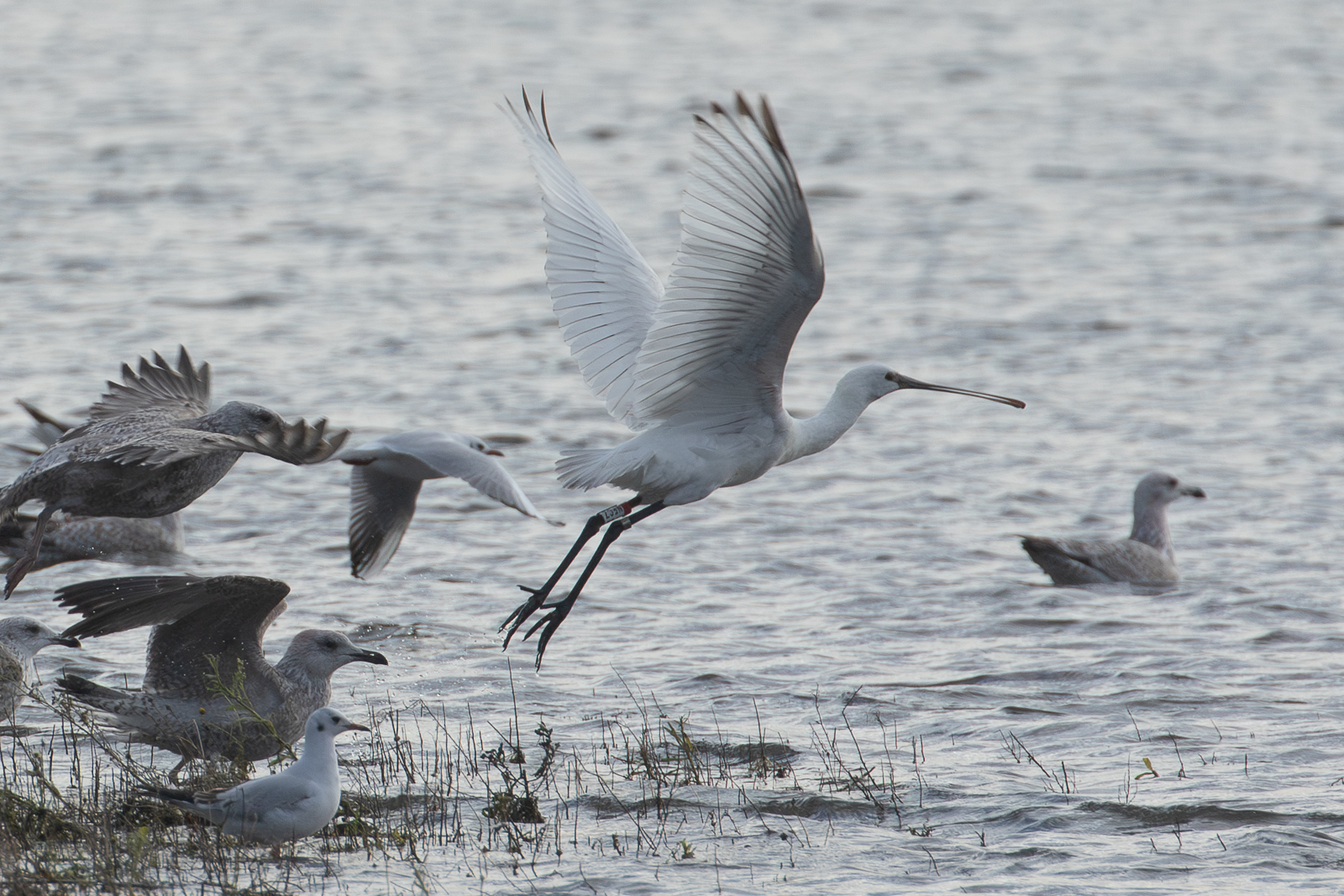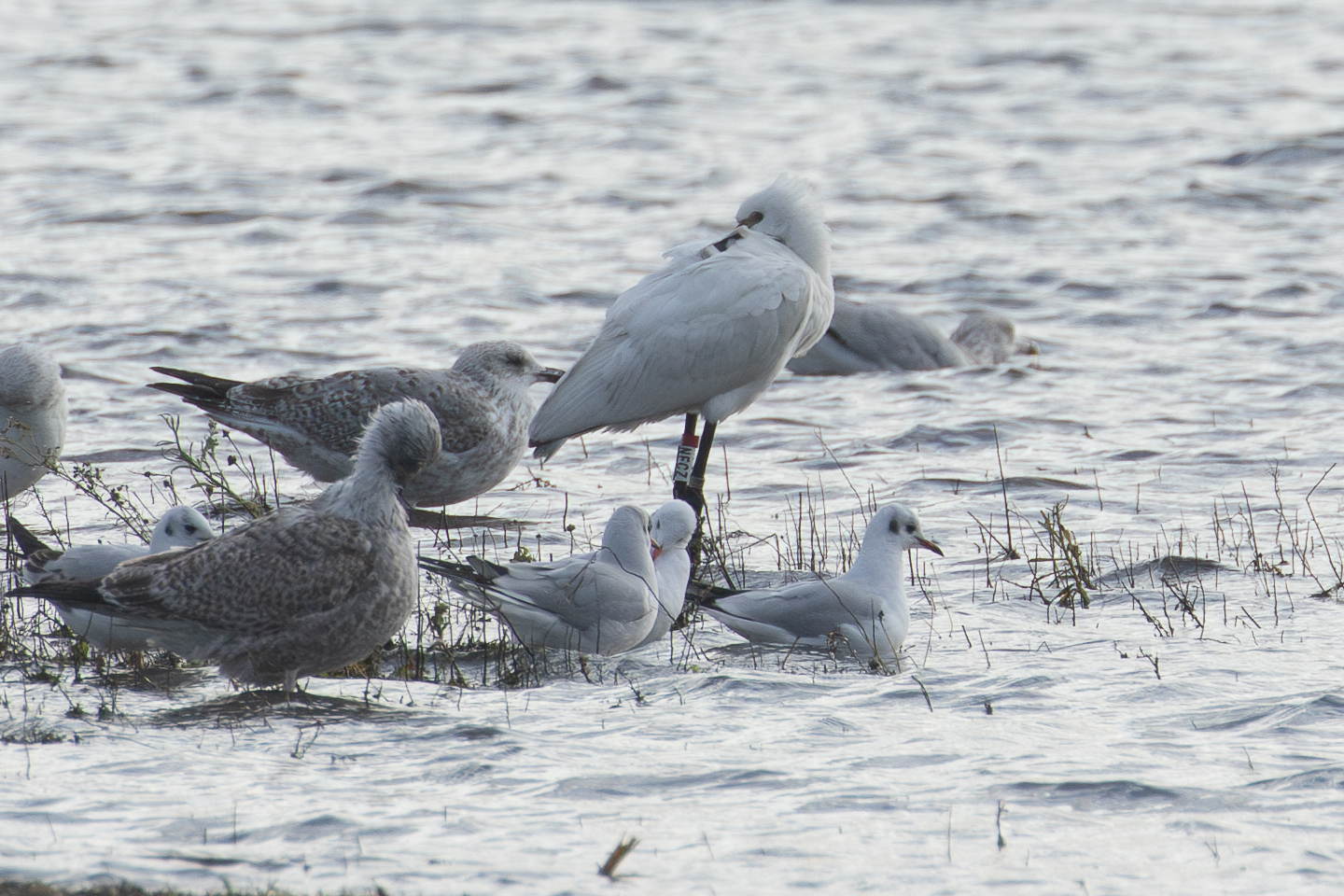In 2023, the Spoonbill Working Group, in collaboration with the University of Groningen BirdEyes, local nature conservation organizations and the crews of the Asterias and Harder, provided 671 spoonbill chicks with a color ring. Most chicks were ringed on the Wadden Islands and in the Delta, but they were also ringed at Onderdijk Vooroever and on the Kinseldam. In addition to ringing them, they were also measured, weighed and we took samples for bird flu. During the ringing we were helped by local nature conservation organizations. About 800 volunteers in the Netherlands, Europe and Africa have read spoonbill color rings. All that data is now in our database. On Texel, Griend, Schiermonnikoog, Rottumerplaat and on the Kinseldam we were also able to transmit 5 adults and 19 juvenile birds with a GPS tracker.
Everyone can follow the spoonbills almost ‘live’ via the Animal Tracker app and via https://maps.nioz.nl/spoonbills-NL/ . In addition, anyone can browse recent and historical spoonbill transmitter data via the Global Flyway Network website https://www.globalflywaynetwork.org/tracks/species/Platalea%20leucorodia
Those tagged spoonbills have experienced a lot of adventures in 2023. See also the other news on our website.
The spoonbills left their breeding areas and pre-gathering areas in the Netherlands very late. The question is whether this had to do with the warm weather in September and October. The whole southward migration was special. Take a look for yourself at the various websites and apps, which complement each other. Below is a brief overview of what the situation was at the end of December for two spoonbills.
Meep
Starting with Meep, a young spoonbill that was tagged on Griend in June. He or she stayed in Friesland for a very long time, mainly along the coast of the IJsselmeer.
Meep, Nieuwe Driemanspolder (Leidschendam) - Foto: Sjaak Schilperoort Meep, Nieuwe Driemanspolder (Leidschendam) - Foto: Sjaak Schilperoort

Several people visited her to see if he/she was alone or in a group. This varied from 80 spoonbills in north-west Friesland to two in the Nieuwe Driemanspolder.
Meep is the northernmost wintering tagged spoonbill in 2023.
Niroumi
The southernmost is Niroumi, an adult female spoonbill from Schiermonnikoog. She was given the name Niroumi when we caught her and found out that she already had color rings indicating that she wintered in Mauritania at the Banc d’Arguin on the island of Niroumi in 2022. Niroumi left Schiermonnikoog on June 23 (with or without her chicks) and stayed mainly on the Groningen coast near Hornhuizen until September 5, with some trips to the Lauwersmeer. Via the coast of Belgium and France she arrived in the Gironde delta on September 9, went to the nature reserve Le Teich, where she stayed for almost a month. Then she left for southern Spain on October 5, to the salt pans of the Parque Natural La Bahia de Cadiz. That is the place from which the spoonbills that winter in Africa leave. See the website https://limesplatalea.blogspot.com
Every year, hundreds of volunteers stand on the roof of a hotel in the southern Spanish village of Chiclana to count the spoonbills that migrate from Europe to Africa. Every day there are at least three volunteers who record the size of the migratory spoonbill groups, the numbers of juveniles (with black wing tips) and the weather conditions. Most likely Niroumi was seen by these volunteers flying by on October 20. She landed on October 21 at the mouth of the Tensift River in Morocco. She continued on October 22 to the mouth of the Massa river south of Agadir. There she stayed. She did not fly on to the Banc d' Arguin in Mauritania.
And so there is a story to be told about all tagged spoonbills. It was a strange autumn, as already written, the spoonbills were migrating late, and most spoonbills stayed in France, Spain and Portugal. The heavy south-westerly storms in Spain and Portugal in October even led to 1 adult spoonbill in northern Spain turning around and flying to France within three days and 2 young birds dying in that storm. One seems to have crashed into a windmill on top of a mountain in northern Spain. In Spain, volunteers started searching for the dead spoonbills, but all they found were transmitters, some feathers and bitten-off harnesses. Several young spoonbills did not make it to the end of 2023. We know from spoonbill survival calculations that 60% of young spoonbills do not survive the first year. (Lok et al. 2011) . There are also plenty of causes of death: being a juvenile spoonbill you have to master the art of eating independently, learn to fly and not exhaust yourself, avoid high-voltage power lines and windmills, learn where the hunting spots are in France and hope that you end up in places where there is plenty of food. And if you decide to winter in the Netherlands like Meep, keep your fingers crossed for ice-free weather.
If you want to read and watch more about the spoonbill research in 2023, read the previous news and Newsletters of the Werkgroep Lepelaar, go to the website of the Dutch Ornithological Union, where there is a recording of the lecture that Petra de Goeij gave about Sinagote and other spoonbills on the National Bird Day in 2023, read the article in Trouw by Rob Buiter about the work of Werkgroep Lepelaar, listen to the interview for Vara’s Vroege Vogels that Rob Buiter made on Griend and watch the interview on RTV-Noord about Lepelaars in the Lauwersmeer.

